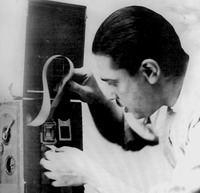A Voice from the Past
I Studied Cinema in Germany
Thanks to Egyptian Cigarettes
By the Cinema Photographer, Mr. Mohamed Bayoumi

Mohamed Bayoumi
In the section “Believe it or Not”, we had remarked that the photographer Mohamed Bayoumi was one of the first to work in the cinema in Egypt. … And here he is, narrating for us some of his memories about studying photography in Germany, and his first effort at producing Egyptian films.
Throughout my education, and up until I joined the army, photography has been my first love. The “camera” was my constant companion.
In 1919 I was made a reservist because I had participated in the national movement. As Germany had flung its doors wide open in welcome of Egyptian students, I spent 6 months there, spending my few pounds in it to enjoy its famed arts and photography. I spent 7 days in the Leipzig exhibition, concentrating on the cinema photographic equipment, and a desire was born within me to study this art.
When I settled in Berlin, I did all I could to get closer to those working in the cinema. Egyptian cigarettes had a major role to play in cementing the friendship between me and the master of German directors, Wilhelm Carol, who paved the way for me in Diva Studios: first as a visitor, then as a second. An excellent second had nominated me to work with him in a film because of my black hair and eyes.
While I was immersed in the Berlin cinema circles, I met the German photographer Boehringer. I became friends with him because of Egyptian cigarettes, which had a magical effect on Germans!
This photographer was most generous with whatever information he had regarding the art of cinematic photography. He eventually made me his assistant, and so I started practicing photography. Afterwards, I worked in a lab for developing and printing film, and studied all I needed to know in that area.
In October 1921 I left Germany, armed with a wealth of information I was determined to bring to Egypt to revive a new industry that was non-existent. I suggested the idea of establishing a cinema company to some wealthy gentlemen, but none believed that such a venture would succeed in Egypt. So I decided to undertake the project myself. I brought the equipment with the help of my friend the photographer, Boehringer. I started by directing a cinematic newsreel called Amon, and used to shoot it myself, and develop and print it all in the small lab I had created.
I was not content with this newsreel, and decided I wanted to produce films so that I could give the audience Egyptian films. The first film I produced was a light comedy with a popular theme. It was natural therefore that the heroes of the film would eat the traditional Egyptian meal: a pot of molokhiya. But it was this pot that caused the film to be censored; the censor claimed that this pot ridiculed the Egyptian people, and banned the film!
I took this shock well, and embarked on directing another comedy called Master Bahbah Looks for Employment. I gave the main part to my young son, and with him there were famous actors such as the late Beshara Wakim, and Abdel Hamid Zaki and Fardous Hassan. But before the film was finished, my son died. It was a terrible shock, and I could not go on with the film.
In 1924 I contacted the late Talaat Harb Pasha, and proposed to him that I would film the stages of constructing the new building of Bank Misr from beginning to end. He welcomed the idea. The execution of the idea was the beginning of the contact between me and the Bank.
One of its employees thought of establishing a cinema studio affiliated to the Bank. This idea resulted in the fact that I moved my cinema lab to the Bank in February 1935, and from then till 1936 I worked for the Bank as a cinema photographer. I then resigned from this job to establish a studio specialized in photography in Alexandria.
My sojourn in the port lasted for a while, till I was called to the Egyptian army in 1937, after I had been an army reservist for around 20 years. Most of my service was spent in the Western Desert, and my task was to move the Bedouins from the danger zones behind the fighting armies.
After that I volunteered in the Palestine war, and when it was over I withdrew, watching from afar the development of Egyptian life and art, which has been remarkable.
El Kawakeb. No. 25, February 1951.

